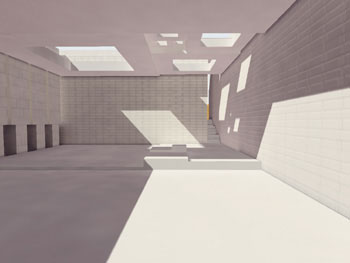Virtual Interactive Architecture
Thanks to information technology, architectural design has made its dynamic character explicit in visible forms.

Let's think about architectural design; however, not to the completed one but to the one in progress. I mean the design of the invention, which is a discovery. That drawing, mirror of the designer's soul, in the depths of which, before being built, architecture and its idea are hidden.
Well, I wonder, what disruptive effect has the information revolution produced on this indispensable tool of the architect's creativity?
I answer: the metamorphoses.
Let me explain: whereas sketches, technical drawings and models constituted as many distinct moments in the design process, today they constitute a single and continuous flow. In the computer environment, in fact, drawings and models, images of any kind and three-dimensional representations are transformed into each other. Any metamorphosis is possible: from a sketch you can induce a virtual model and from this a physical model (rapid prototyping); then, if desired, it is also possible to carry out the reverse process: from the three-dimensional scanning of the model, to the mathematics of its shape (reverse engineering). These transformations have become so simple and powerful that it is difficult to distinguish the old forms of drawing, which are increasingly hybrid. Therefore, the use of an older word with a broader semantic spectrum is required: this word is a model.
The changing representations of architecture are all models, transforming into each other. With each transformation the model enriches and perfects its information content and therefore the models are ordering themselves in a vortex that converges towards the design idea and finally realizes it.
Thanks to information technology, therefore, architectural design has made its dynamic character explicit in visible forms. And just as in the past the perspective has marked the highest point of the representation of architecture, for its association with art and for its ability to bring space back to man, so today the interactive dynamic model represents the point higher in the metamorphosis of the models, for the same reasons: its proximity to artistic expression and the ability to introduce man into the space he has imagined.
There is only one difference, not negligible: a perspective can be seen through the eyes of the person who made it, it is an experience that is not ours, but exclusive to the designer. An interactive dynamic model, on the other hand, is the unique and unrepeatable experience of those who walk through it putting themselves at the controls of the virtual space it represents. And, therefore, it is a shareable design experience, just as the architecture created is shareable.
This unique character of the interactive dynamic model, however, has a dramatic consequence: it is not possible to bring the model onto the pages of a newspaper and, even if it were possible, it would not be possible to show how it works. The interactive dynamic model is not an animation. If one day it will be possible to enter an auteur film to interact with the characters and experience the story from the inside (hasn't Pirandello already done so in the theater?), Then we will have the most effective example to explain what it is.
Riccardo Migliari
(with the contribution of MIUR in the context of the PRIN 2005 research)
































































